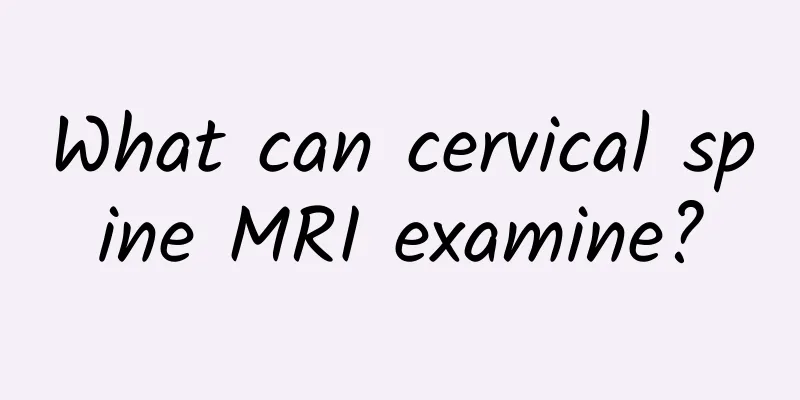What can cervical spine MRI examine?

|
If you suspect there is a problem with your cervical spine, you can go to the hospital for an MRI, which is an MRI scan of the neck and surrounding areas to diagnose whether there is any lesion in the cervical spine. It is of relatively important clinical significance and can have a good diagnostic effect on some malignant tumors and vascular lesions of the neck. Once a disease problem occurs, symptomatic treatment can be used. In normal values, subcutaneous fat and bone marrow show high signals on T1WI, T2WI and proton density images; bone cortex, air, ligaments, tendons and fibrocartilage show low signals; muscles and hyaline cartilage of joints show moderate to low signals. Fluid, such as joint effusion, inflammation or edema, and tumor tissue have low signal on T1WI and high signal on T2WI. Hematoma will present signals of varying intensities depending on the duration of bleeding. Examination revealed no abnormal lumps or areas. Clinical significance (1) Benign or malignant tumors of the neck; (2) Vascular lesions of the neck; (3) cystic lesions of the neck; (4) granulomatous lesions of the neck; (5) Swollen lymph nodes in the neck. The soft tissue in the front of the neck is rich in blood vessels. To eliminate vascular pulsation artifacts, saturation bands can be added to the proximal and distal ends respectively; for severe arterial pulsation artifacts, ECG and pulse synchronous acquisition technology can be used; for cervical vascular lesions, 2D (3D) TOF or PC vascular imaging technology can be used, or 3D-CE-MRA technology can be used with the addition of enhanced contrast agents. People who need to be checked: People with neck pain or abnormal pain around the neck. The examination process uses a head and neck combined coil, a neck phased array coil, or a neck surface flexible coil (depending on the scanning area). The patient lies in supine position with the head advanced and placed in the coil. The midsagittal plane of the head is consistent with the XO plane; the line connecting the bilateral palpebral fissures is parallel to the ZO plane, and the bilateral temporal parts and ears are fixed to prevent movement. The center of the coil's horizontal axis is aligned with the center of the examination area. Conventional imaging orientation and sequence: The nasopharynx, oropharynx, larynx and thyroid gland are routinely imaged using transverse axial T1WI and T2WI in combination with coronal or sagittal T1WI or T2WI. The conventional layer thickness is 3-5mm, the interval is 20%, and the phase encoding direction is: LR direction for the transverse section, AP direction for the sagittal plane, and LR direction for the coronal plane. Contrast agent enhancement: Contrast agent: 0.5mol/L (Gd-DTPA), 0.1mmol/Kg, intravenous injection at a rate of 0.5-1mL/s. Scanning sequence: T1WI scans were performed in the transverse, coronal, and sagittal planes for the lesions. |
<<: How long does it take to recover from anterior cervical spine surgery?
>>: Why does the cervical spine make a sound when moving?
Recommend
Red spots around the female urethra
If there are red spots around the urethral openin...
Itchy blisters on hands
When it comes to human organs, there are many kin...
Early symptoms of prostate cancer
The early symptoms of prostate cancer are not so ...
What causes calf sweating?
Some people may be surprised to see sweat in thei...
Drooling when sleeping smells bad. Do you know these hidden dangers?
In real life, most people have experienced drooli...
Medicine for skin allergies
Many people suffer from skin allergies, some are ...
Taboos and precautions for eating Taohuaji donkey-hide gelatin cake
Taohuaji donkey-hide gelatin cake is a high-end t...
Aloe Vera Allergy Symptoms
Aloe vera gel has a good beauty and skin care eff...
What are the medicinal values of ground ivy?
Herba Epimedii is a very famous Chinese medicinal...
What causes arm pain?
People's arms are very important parts of the...
Itching inside the ear
Itchy ears are a very common phenomenon. Many peo...
What are the benefits of taking a dandelion bath?
Dandelion is a very magical plant. The reproducti...
Why do some babies have high alkaline phosphatase?
If a baby shows some abnormal conditions, don'...
Why does my waist hurt after lying down for a long time?
As the saying goes, standing is not as good as si...
What is anxiety disorder called in Chinese medicine?
Anxiety disorder is a condition that people are p...









